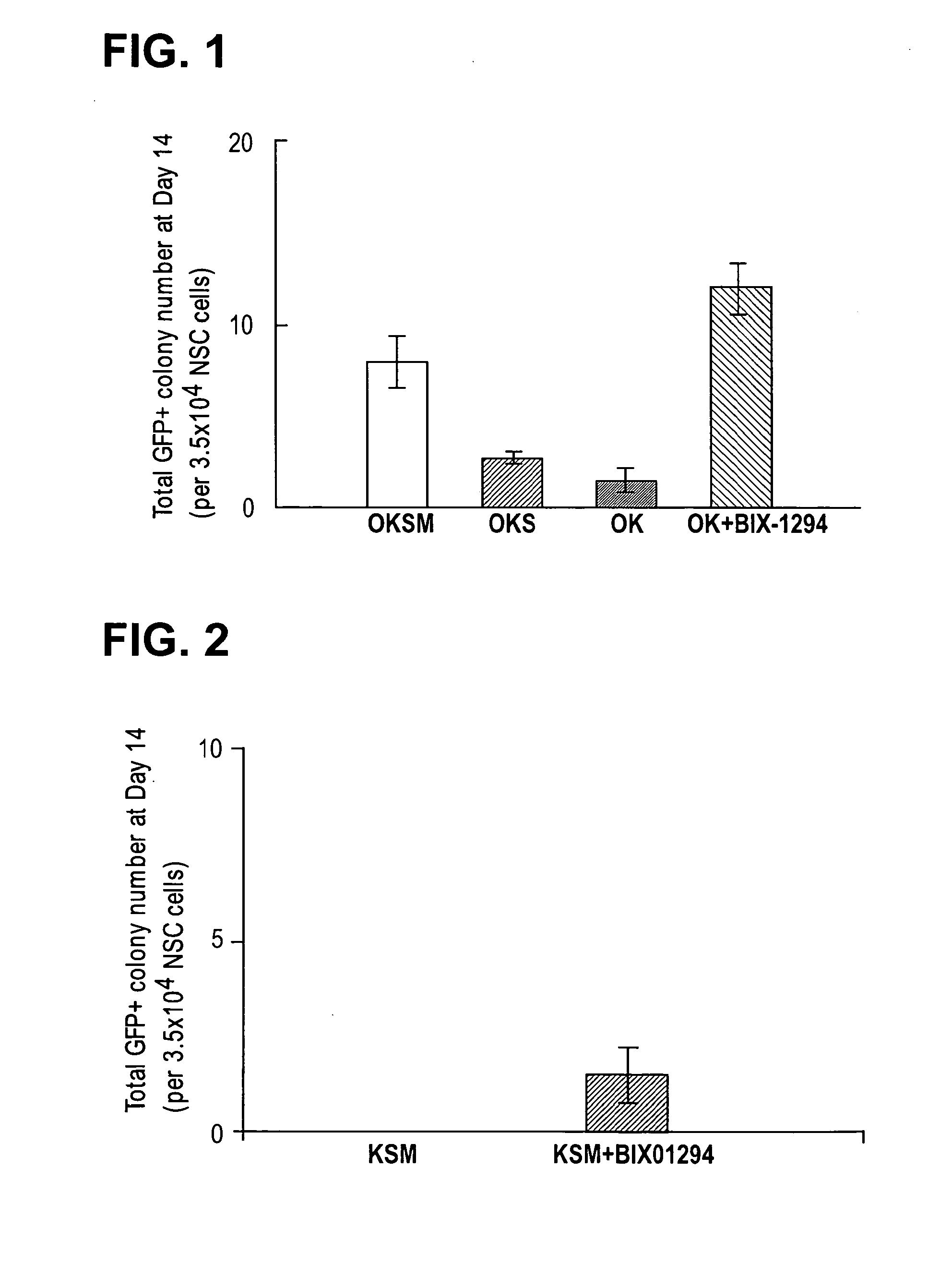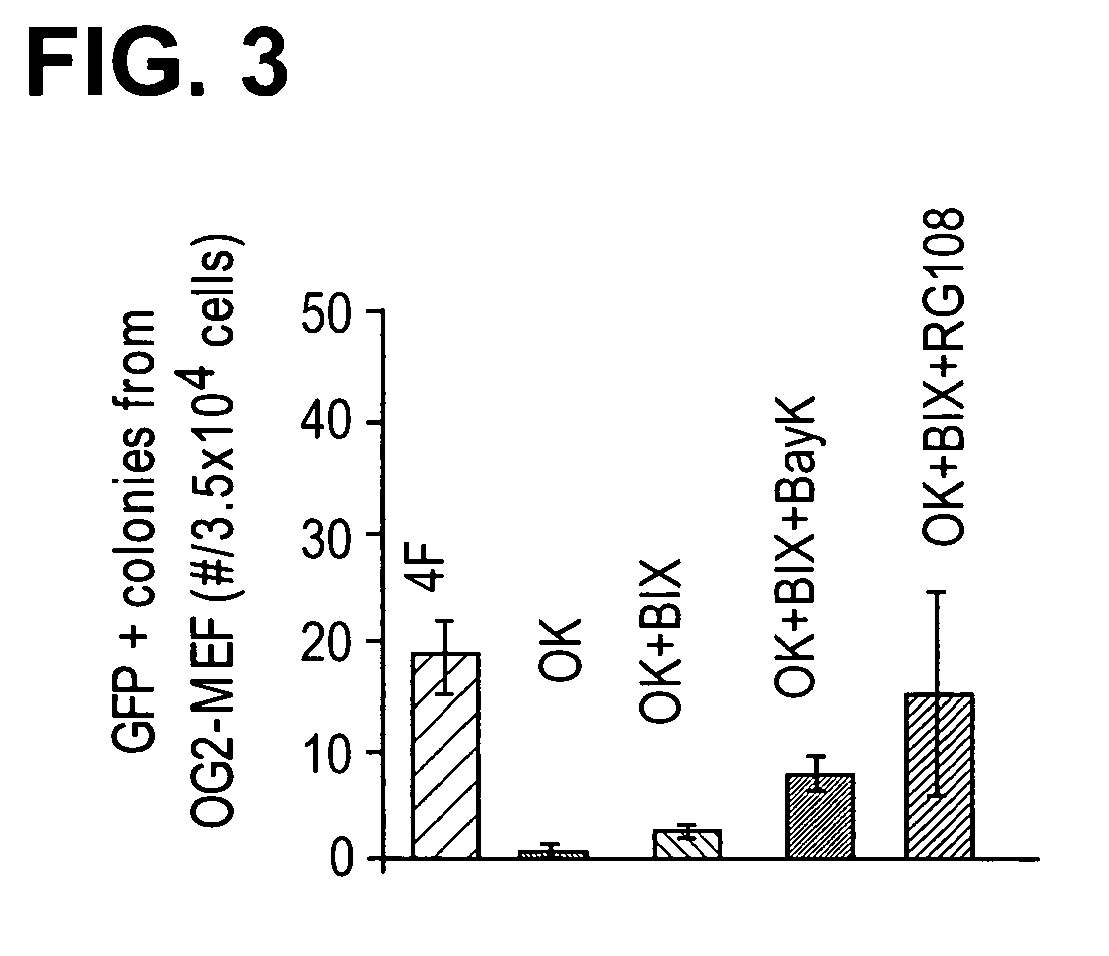Combined Chemical and Genetic Approaches for Generation of Induced Pluripotent Stem Cells
a technology of induced pluripotent stem cells and combined chemical and genetic approaches, which is applied in the direction of cardiovascular disorders, drug compositions, metabolic disorders, etc., can solve the problems of much slower reprogramming kinetics and substantial reduction of reprogramming efficiency
- Summary
- Abstract
- Description
- Claims
- Application Information
AI Technical Summary
Problems solved by technology
Method used
Image
Examples
example
Example 1
[0325]Toward identifying conditions that can replace viral transduction of oncogenic transcription factors (e.g. cMyc and Oct4 (Hochedlinger, K. et al., Cell 121, 465-477 (2005)) and enhance reprogramming efficiency, we sought to exploit combination of two approaches: one was to examine a defined progenitor cell type based on the notion that certain accessible adult progenitor cells may endogenously express at certain level some of the required genes for inducing pluripotency and / or the loci of these genes may be less silenced so that such progenitor cells might be more efficiently reprogrammed and / or with less genetic manipulations; the other approach was to screen small molecules that may be able to replace viral integration of specific transcription factor and / or promote reprogramming process.
[0326]Among various adult stem / progenitor cells that are accessible from different tissues, we initially focused our efforts on neural progenitor cells for the following reasons: (i...
example 2
[0339]Somatic cells can be induced into pluripotent stem cells (iPSC) with a combination of four transcription factors, Oct4 / Sox2 / Klf4 / c-Myc or Oct4 / Sox2 / Nanog / LIN28. This provides an enabling platform to obtain patient specific cells for various therapeutic and research applications. However, several problems remain for this approach to be therapeutically relevant due to drawbacks associated with efficiency and viral genome-integration. As explained above, neural progenitor cells (NPCs) transduced with Oct4 / Klf4 can be reprogrammed into iPSCs. However, NPCs express Sox2 endogenously, possibly facilitating reprogramming in the absence of exogenous Sox2. In this study, we identified a small molecule combination, BIX-01294 and BayK8644, that enables reprogramming of Oct4 / Klf4 transduced mouse embryonic fibroblasts, which do not endogenously express the factors essential for reprogramming. This study demonstrates that small molecules identified through a phenotypic screen can compensat...
example 3
[0362]This example demonstrates that incubation of mammalian cells with transcription factor proteins is sufficient to induce pluripotency.
Gene Construction:
[0363]In order to obtain the high level protein expression in E. coli, all four human TF gene codon region were optimized first (G A Gutman and G W Hatfield (1989). PNAS. vol. 86. pp: 3699-3703), and full-length synthesized using DNA oligo based / PCR gene assembling technology (Danilo R Casimiro, Peter E Wright & H Jane Dyson. (1997). Structure. Vol. 5. pp: 1407-1412). Poly-arginine tag: ESGGGGSPGRRRRRRRRRRR was added to each protein C-terminal in design (Gump J M, Dowdy S F. (2007) Trends Mol. Med. 2007 October; 13 (10):443-8). The final DNA fragment was flanked with NdeI and XhoI site, and inserted into pET41 expression vector NdeI-XhoI sites for protein expression. Each plasmid were verified with DNA sequence, then transformed into BL21start competent cells for recombinant protein production using auto-induction medium overnig...
PUM
| Property | Measurement | Unit |
|---|---|---|
| molecular weight | aaaaa | aaaaa |
| molecular weight | aaaaa | aaaaa |
| molecular weight | aaaaa | aaaaa |
Abstract
Description
Claims
Application Information
 Login to View More
Login to View More - R&D
- Intellectual Property
- Life Sciences
- Materials
- Tech Scout
- Unparalleled Data Quality
- Higher Quality Content
- 60% Fewer Hallucinations
Browse by: Latest US Patents, China's latest patents, Technical Efficacy Thesaurus, Application Domain, Technology Topic, Popular Technical Reports.
© 2025 PatSnap. All rights reserved.Legal|Privacy policy|Modern Slavery Act Transparency Statement|Sitemap|About US| Contact US: help@patsnap.com



